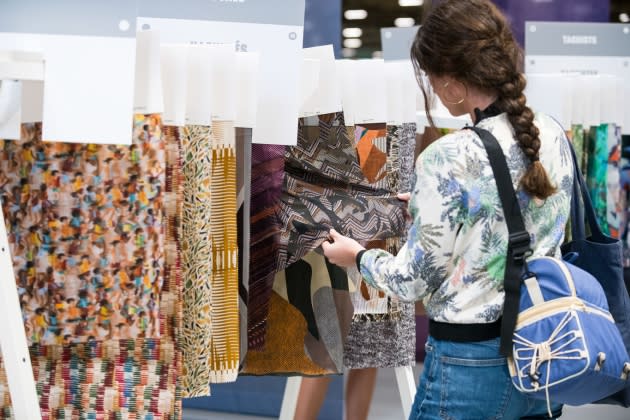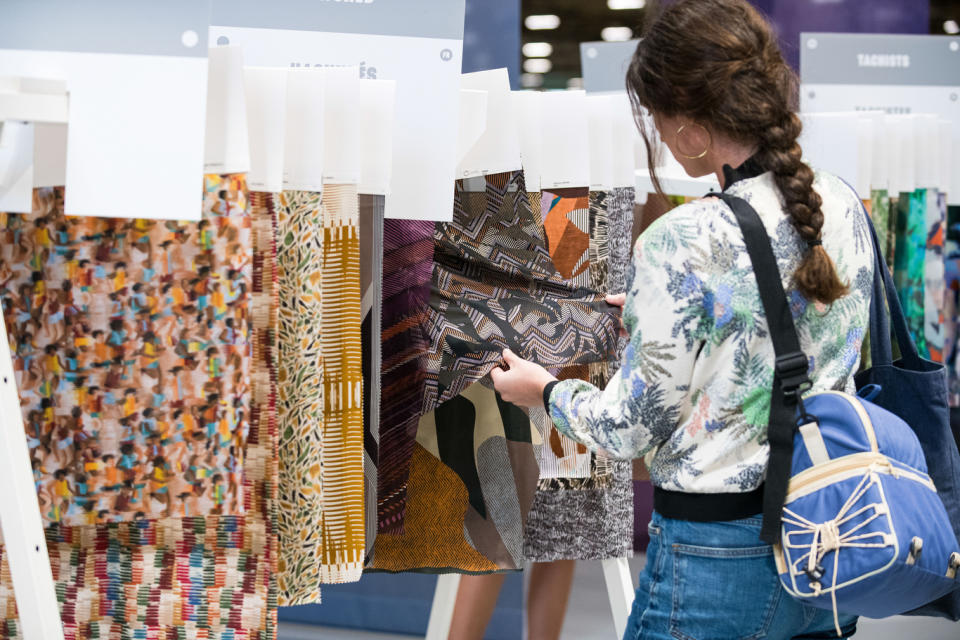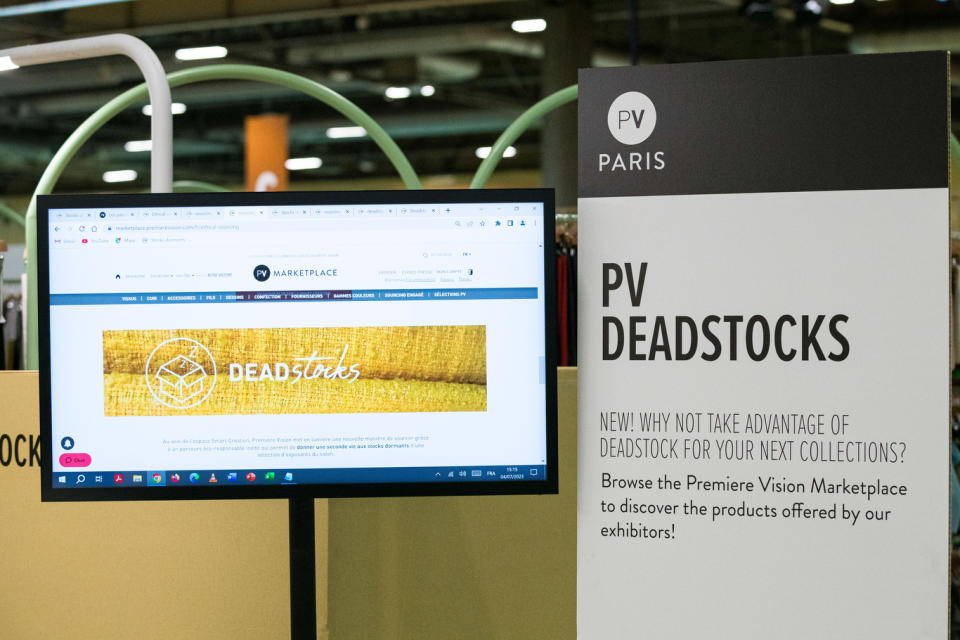Première Vision, Texworld Paris Fairs Keep Pace With Rapidly Changing World

PARIS — Despite a backdrop of social unrest across France, with the U.K. issuing a travel advisory for the country, the latest round of Première Vision celebrated its 50th anniversary with a 7 percent increase in visitor numbers versus July 2022.
The global textile fair welcomed 25,117 visitors, 70 percent from outside France, and 1,315 exhibitors, up 10 percent versus the previous July. “This edition confirms the progressive return of professionals from Asia, and particularly China,” stated Gilles Lasbordes, director of Première Vision.
More from WWD
Gen Z May Be in for Traditional Suiting, According to Textile Makers
Men's Showrooms, Trade Shows, Agencies Banding Together in July
Seminal Edition of Kidswear Fair 'Children's Show' to Be Held in New York
Meanwhile, Texworld Evolution Paris, which marked its 25th anniversary with the show’s move to Porte de Versailles, revealed future editions will also take place at the south of Paris exhibition center. Texworld welcomed 6,800 visitors to its three-day run.
Among invited experts addressing the macro challenges facing the industry in the face of climate breakdown and looming risk of a global economic recession, Zhang Tao, vice president of China’s Sub-council of Textile Industry, told Texworld’s opening press conference that China is establishing a greener supply chain.
With China representing 32 percent of the European Union’s clothing imports, Tao said the country is working to modernize its industry, accelerate digitization and forge deeper ties with Europe’s textile and apparel sector. He noted that China’s textile exports to the EU were up 11 percent in 2022.
Citing France’s riots among a series of never-ending crises in his overview of mega trends for 2024 and beyond, Vincent Gregoire, director of consumer trends and insights at consulting agency Nelly Rodi, identified the paradoxes of our times.
“People are lost, people are troubled. There’s threat of conflict,” he said, naming “the fight between the elite and the people.” He observed a societal shift, particularly in France, toward a degrowth mindset.
“There’s hate towards the rich, the people who are supposed to be responsible for the ecological mess,” he said. “Before people wanted to be rich, it was very aspirational. Now de-consumption could be a new model.”
Another paradox is the current momentum in artificial intelligence, and the potential risk of a lack of electronic components as a result of any conflict in Taiwan, he continued. There’s also a paradox between uniformization, he said, “the Zara-ization the IKEA-ization, AirBnB-ization” of the world and yet a parallel return to the local with talk in France, for example, of the 15-minute city.

Similarly, the economic crisis has exacerbated the conundrum for Gen Z shoppers who love vintage, with 65 percent of American students declaring they’d like to buy more sustainably and yet 72 percent still consuming fast fashion, noted Béatrice Sutter, director of l’ADN, a French media in digital culture agency, citing market data by GlobalData for ThredUp.
For Gen Z, price is the number-one factor in this paradox. “The desire to consume in a more sustainable way gives way to the need to make cost savings,” she said.
In a bid to facilitate the more sustainable sourcing journey, Première Vision unveiled its “better way” program which analyzed 290 participating exhibitors’ initiatives, using pictograms on the stands to make it easier to navigate for showgoers.
Returning to Première Vision for the first time since before the coronavirus pandemic, Nikki Player, director of materials for Reformation, said sustainability was top of her sourcing criteria this year with a “focus on circular, low footprint, next-gen materials both in commercial and pilot stages.”
“I found the show to be highly productive and improved over past seasons,” said Player. “For my needs it is helpful to see a cross-section of price points and countries of origin, all through the filter of genuine sustainability. I was impressed to see a larger presence of innovators at PV, also to see progress that many of the historic European mills are making in both their social and environmental sustainability journeys.”
Among historic European mills, Manteco celebrated the 80th anniversary of its wool recycling business, its founder having started to recycle military garments in 1943. Two workers demonstrated live on its stand the machine process of transforming discarded wool items — drawing crowds of professionals to witness the process first-hand and leave with their own pack of yarns.
“We let people live the actual experience of how a recycled wool fabric is made,” said Mattia Trovato, Manteco head of communication and photography, as behind him wool items were first sorted by color and condition, then cleaned of any non-recyclable elements.
“This is an installation to make people reflect on the impact of design,” he continued. “Small labels, trimmings, make a big difference. If you design a garment by considering the end of life, you won’t have this waste. We also want to make people understand that recycling is a tough job.”
Among this season’s newcomers, Nona Source, the deadstock initiative of LVMH Moët Hennessy Louis Vuitton, which recovers the luxury group’s leftover fabrics, reported brisk business.
“There are people who hadn’t heard of us,” said Romain Brabo, the start-up’s cofounder. The initiative meets the needs of small designers for limited quantities, but not only, he said, adding that Nona Source picks up deadstock if, for example, a brand in the group cancels an order for a collection, or when minimum quantities need to be met. “They need 200 meters and they had to order 400, so we retrieve what’s left,” he said.

Also showing for the first time at Première Vision, U.S. company Repreve, which claims to have transformed 35 billion plastic bottles into recycled polyester fabrics, noted that the brand is rolling out its textile take-back schemes and keeping a close eye on European legislation for textiles.
“It feels like it changes every 10 minutes; it’s something our legal team is looking at,” said Bev Sylvester, Repreve vice president of marketing and communications. “The intent is very good, it’s about how it’s executed,” she added.
Among next-gen materials, original pioneers in the field expanded collections into new fabric types: bio-based materials pioneer Spiber, which counts clients including Kering, is working on a new fur-like material made with its fermentation process.
Pyratex presented its first knitwear developed with its bio-based yarns and is now working with Robur, a French uniform company, to make uniforms with natural fibers that could resist 90-degree washing.
Among trends in PV’s forecast for fall-winter 2024-25 were everything from natural harmonies and graduated patterns with light infused backgrounds, to techno couture, fabrics woven with lamé and optical geometry.
Sera Ulger, a print designer and textiles rep working with high street brands and looking for prints for the unisex collection launching for her own brand Sera Ulger London, said standouts included Bauhaus geometric prints at Erica Industria Tessile, plus the decorative William Morris/Art Nouveau designs at the trend forum.
“I love everything sea-life inspired, and there were some gorgeous buttons dotted around PV. I think the sea life concept in fashion will continue on and we will expand on our creativity with it merging it with clothes and accessories,” said Ulger, who plans to launch a summer collection on the theme.

While exhibitors put a quiet third day at Texworld down to the unrest across France, U.K. buying teams seemed unaware there had been U.K. government-issued travel advice on monitoring the media for disruption in the country.
“I didn’t get the memo, we haven’t seen anything,” quipped a buyer for a major U.K. value retailer, who preferred to remain anonymous due to company media policy. “I’m hearing from the stands it’s a bit quieter than previous years,” she said. “Texworld is really positive for us, for building relationships, and it’s better for us to come here in person.”
“For us, this is local, and we’ve found everything we’re looking for,” echoed Julia Hesketh, account manager at Wealth Industrial, which designs girls’ wear, including denim, knit and prints, for major names on the U.K. high street. Hesketh’s design team named Texworld’s selection of Korean fabrics as a standout.
Shopping Texworld for menswear fabrics for Country Road group, one of the largest specialty Australian retailers, Paul Burden, head of design for Politix, named the drapery and tailoring fabrics at Chinese supplier Langyitex as among his favorites.
“It’s hard with these shows for the Southern Hemisphere. Our mind is on spring-summer, so we’re out of sync,” he said. For his collections for Politix, he is looking to recolor to meet the summer season and is moving toward more European fabrics.
Texworld is set to return to the Porte de Versailles exhibitions halls next February, having previously been held at the Paris Le Bourget exhibition center North of Paris. Première Vision’s next Paris show is its Rendez-Vous on Sept. 13 at the Grand Palais Éphémère.
Launch Gallery: Inside the Première Vision, Texworld Paris Trade Shows
Best of WWD


